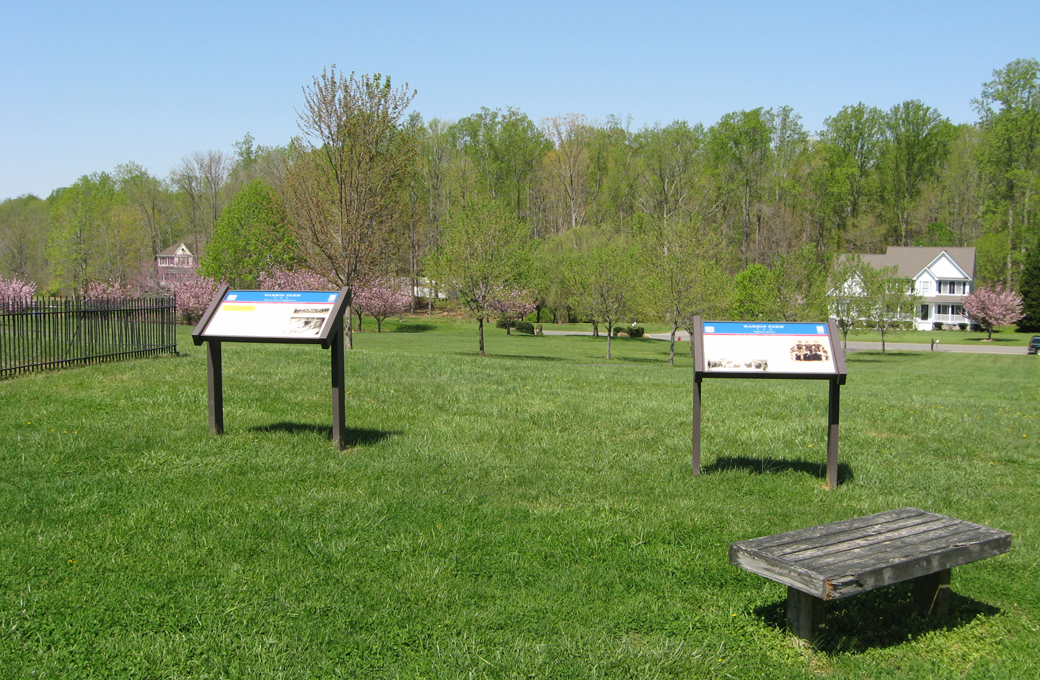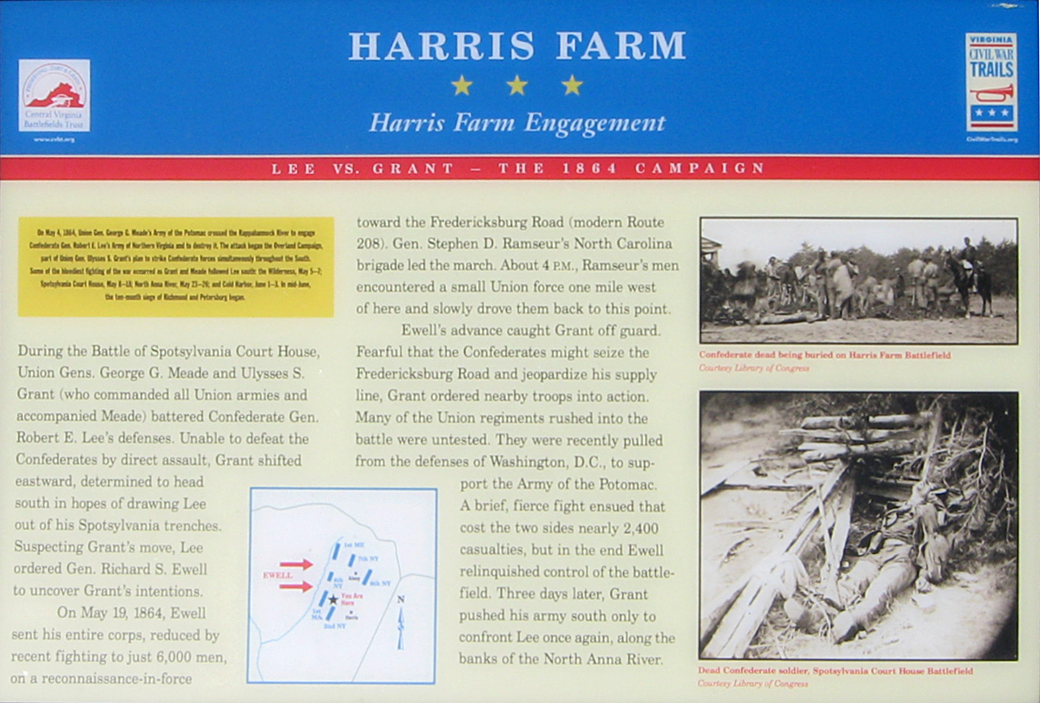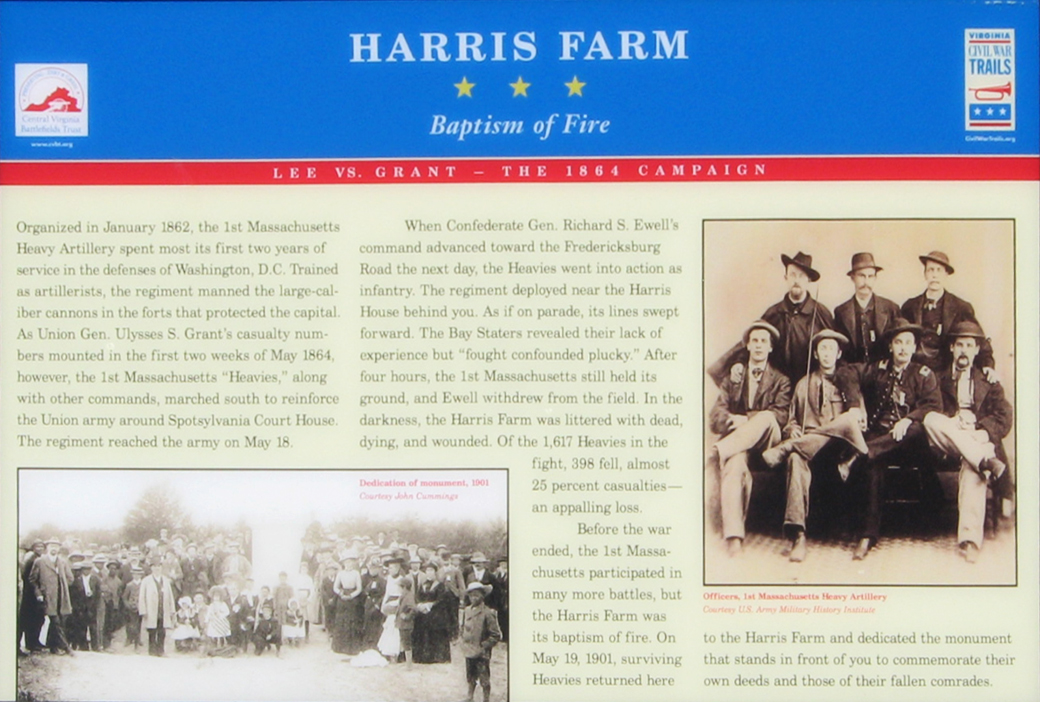Battle of Spotsylvania • Harris Farm
The “Harris Farm Engagement” and “Harris Farm – Baptism of Fire” wayside marker are on a hillside in a residential neighborhood off Courthouse Road. They are next to the monument to the 1st Massachusetts Heavy Artillery.

The “Harris Farm” (left) and “Harris Farm – Baptism of Fire” wayside markers are in a small park in the middle of a subdivision. The iron fence on the left surrounds the Monument to the 1st Massachusetts Heavy Artillery.
Harris Farm Engagement wayside marker

Text from the marker
Harris Farm
Harris Farm Engagement
On May 4, 1864, Union Gen. George G. Meade’s Army of the Potomac crossed the Rappahannock River to engage Confederate Gen. Robert E. Lee’sArmy of Northern Virginia and to destroy it. The attack began the Overland Campaign, part of Gen. Ulysses S. Grant’s plan to strike Confederate forces simultaneously throughout the South. Some of the hardest fighting of the war occured as Grant and Meade followed Lee South: the Wilderness, May 5-7, Spotsylvania Court House, May 8-18, North Anna River, May 23-26, and Cold Harbor, June 1-3. In mid-June, the ten-month Siege of Richmond and Petersburg began.
During the Battle of Spotsylvania Court House, Union Gens. George G. Meade and Uysses S. Grant (who commanded all Union armies and accompanied Meade) battered Confederate Gen. Robert E. Lee’s defenses. Unable to defeat the Confederates by direct assault, Grant shifted eastward, determined to head south in hopes of drawing Lee out of his Spotsylvania trenches. Suspecting Grant’s move, Lee ordered Gen. Richard S. Ewell to uncover Grant’s intentions.
On May 19, 1864, Ewell sent his entire corps, reduced by fighting to jst 6,000 men, on a reconnaissance-in-force toward the Fredericksburg Road (modern Route 208). Gen. Stephen D. Ramseur’s North Carolina brigade led the march. About 4 p.m., Ramseur’s men encountered a small Union force one mile west of here and slowly drove them back to this point.
Ewell’s advance caught Grant off guard. Fearful that the Confederates might seize the Fredericksburg Road and jeapordize his supply line, Grant ordered nearby troops into action. Many of the Union regiments rushed into the battle were untested. They were recently pulled from the defences of Washington, D.C., to support the Army of the Potomac. A brief, fierce fight ensued that cost the two sides nearly 2,400 casualties, but in the end Ewell relinquished control of the battlefield. Three days later, Grant pushed his army south only to confront Lee once again along the banks of the North Anna River.
Caption to the top photo:
Confederate dead being buried on Harris Farm battlefield.
Caption to the lower photo:
Dead Confederate soldier, Spotsylvania Court House Battlefield.
Courtesy Library of Congress
Harris Farm – Baptism of Fire wayside marker

Text from the marker
Harris Farm
Baptism of Fire
Organized in January 1862, the 1st Massachusetts Heavy Artillery spent most of its first two years of service in the defenses of Washington, D.C. Trained as artillerists, the regiment manned the large-caliber cannons in the forts that protected the capital. As Union Gen. Ulysses S. Grant’s casualty numbers mounted in the first two weeks of May 1864, however, the 1st Massachusetts “Heavies,” along with other commands, marched south to reinforce the Union army around Spotsylvania Court House. The regiment reached the army on May 18.
When Confederate Gen. RIchard S. Ewell’s command advanced toward the Fredericksburg Road the next day, the Heavies went into action as infantry. The regiment deployed near the Harris House behind you. As if on parade, its lines swept forward. The Bay Staters revealed their lack of experience but “fought confounded plucky.” After four hours, the 1st Massachusetts still held its ground, and Ewell withdrew from the field. In the darkness, the Harris Farm was littered with dead, dying and wounded. Of the 1,617 Heavies in the fight, 398 fell, almost 25 percent casualties – an appalling loss.
Before the war ended, the 1st Massachusetts participated in many more battles, but the Harris Farm was its baptism of fire. On May 19, 1901, surviving Heavies returned here to the Harris Farm and dedicated the monument that stands in front of you to commemorate their fallen comrades.
Caption to the photograph on the left:
Dedication of monument, 1901
Courtesy John Cummings
Caption to the photograph on the right:
Officers, 1st Massachusetts Heavy Artillery
Location of the Harris Farm wayside markers
The monument and wayside markers at Harris Farm are in a residential neighborhood off Courthouse Road. When leaving Spotsylvania Battlefield Park turn left and proceed 1.4 miles on Courthouse Road. Turn left onto Bloomsbury Lane (there is a left turn lane) and proceed 0.8 mile. Continue straight onto Monument Court when Bloomsbury Lane turns left, and proceed 0.3 mile to Knob Hill Court. The monument and wayside markers are up a short hill on the right. (38°14’02.7″N 77°34’12.7″W)
